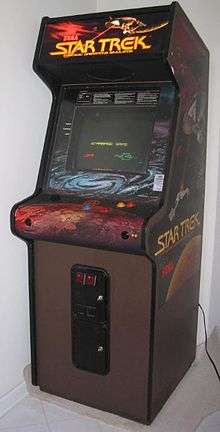Star Trek (arcade game)
| Star Trek | |
|---|---|
 Star Trek cabinet | |
| Developer(s) | Sega |
| Publisher(s) | Sega |
| Designer(s) | Sam Palahnuk |
| Platform(s) | Arcade |
| Release date(s) |
|
| Genre(s) |
Space combat simulation Multi-directional shooter First-person shooter |
| Mode(s) | Single-player |
| Arcade system |
Sega G80 Vector hardware [1] |
| Display | Vector, color |
Star Trek is a space combat simulation arcade game based on the original Star Trek television program, and released by Sega in 1983.[2][3] It is a vector game, with both a two-dimensional display and a three-dimensional first-person perspective.[4] The player controls the Starship Enterprise, and must defend sectors from invading Klingon ships.
The game was presented in two styles of cabinets: an upright standup, and a sit-down/semi-enclosed deluxe cabinet with the player's chair modeled after the Star Trek Motion Picture's bridge chairs with controls integrated into the chair's arms.
Gameplay
The game makes use of painstakingly synthesized speech, since memory costs at the time made the use of sampled audio almost prohibitive.
Unlike most arcade games of the time, the player is presented with multiple views of the play field. Throughout the game, survival depends on the player's ability to effectively use and manage shield energy, photon torpedoes, and warp energy. These are replenished by docking with starbases, which sometimes must be saved from destruction at the hands of the Klingons.
The control system for Star Trek employed the use of a weighted spinner for ship heading control, while a series of buttons allowed the player to activate the impulse engines, warp engines, phasers, and photon torpedoes. The warp button was deliberately placed farther away from the rest of the buttons, in order to force the player to reach for them in heated battle. The sit-down (AKA: environmental) version of the game had convenient location of the warp button at the right hand thumb.
Downloadable link: A_Comprehensive_Guide_To_Winning_Sega_Star_Trek.pdf
Ports
Star Trek - Strategic Operations Simulator was ported to most of the contemporary computers and consoles of the era; namely Commodore 64, TI-99/4A, the Atari 8-bit family, and Atari 5200 in 1983, Tandy Color Computer in 1984 (as Space Wrek), the Atari 2600, Commodore VIC-20, ColecoVision and the Apple II.
Reception
The review in the August 1983 issue of Electronic Games said that "Star Trek is sure to be a top-grosser in the arcades this year. If you can squeeze through the crowd around the machine, you may never want to leave."[5]
References
- ↑ System16.com. Game hardware page. Retrieved August 5, 2006.
- ↑ "Star Trek". The Arcade Flyer Archive. Killer List of Videogames. Retrieved 7 June 2012.
- ↑ US Copyright Database listed date of publication 1983-01-21
- ↑ Star Trek at the Killer List of Videogames
- ↑ Forman, Tracie (August 1983). "Insert Coin Here". Electronic Games. 2 (6): 100.
External links
- Star Trek: Strategic Operations Simulator at MobyGames
- Star Trek: Strategic Operations Simulator at GameFAQs
- Star Trek: Strategic Operations Simulator at the Internet Archive
- A comprehensive tactics guide to winning at Sega Star Trek at Afternight.com